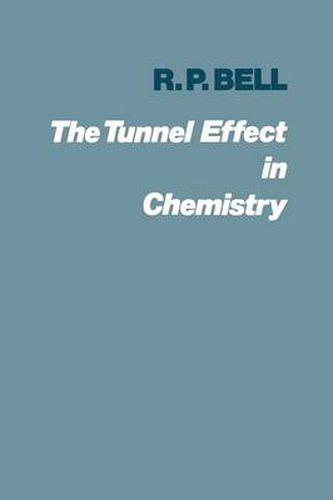Readings Newsletter
Become a Readings Member to make your shopping experience even easier.
Sign in or sign up for free!
You’re not far away from qualifying for FREE standard shipping within Australia
You’ve qualified for FREE standard shipping within Australia
The cart is loading…






This title is printed to order. This book may have been self-published. If so, we cannot guarantee the quality of the content. In the main most books will have gone through the editing process however some may not. We therefore suggest that you be aware of this before ordering this book. If in doubt check either the author or publisher’s details as we are unable to accept any returns unless they are faulty. Please contact us if you have any questions.
The suggestion that quantum-mechanical tunnelling might be a significant factor in some chemical reactions was first made fifty years ago by Hund, very soon after the principles of wave mechanics had been established by de Broglie, Schrodinger and Heisenberg, and similar ideas were put forward during the following thirty years by a number of authors. It was realised from the beginning that such effects would be particularly prominent in reactions involving the movement of protons or hydrogen atoms, and both theoretical and experimental work received a powerful stimulus in the discovery of deuterium in 1932. During the last twenty years theoretical predictions about the tunnel effect have been supported by an increasing body of experimental evidence, derived especially from studies of hydrogen isotope effects. The present book presents an attempt to summarize this evidence and to indicate the main lines of the basic theory. Details of mathematical manipu- lation are restricted mainly to Chapter 2 and the Appendices, and many readers may prefer to confine themselves to the results obtained. The main emphasis has been on the kinetics of chemical reactions involving the transfer of protons, hydrogen atoms or hydride ions, although Chapter 6 gives an account of the role of the tunnel effect in molecular spectra, and Chapter 7 makes some mention of tunnelling in solid state phenomena, biological processes and the electrolytic discharge of hydrogen. Only passing references have been made to tunnelling by electrons.
$9.00 standard shipping within Australia
FREE standard shipping within Australia for orders over $100.00
Express & International shipping calculated at checkout
This title is printed to order. This book may have been self-published. If so, we cannot guarantee the quality of the content. In the main most books will have gone through the editing process however some may not. We therefore suggest that you be aware of this before ordering this book. If in doubt check either the author or publisher’s details as we are unable to accept any returns unless they are faulty. Please contact us if you have any questions.
The suggestion that quantum-mechanical tunnelling might be a significant factor in some chemical reactions was first made fifty years ago by Hund, very soon after the principles of wave mechanics had been established by de Broglie, Schrodinger and Heisenberg, and similar ideas were put forward during the following thirty years by a number of authors. It was realised from the beginning that such effects would be particularly prominent in reactions involving the movement of protons or hydrogen atoms, and both theoretical and experimental work received a powerful stimulus in the discovery of deuterium in 1932. During the last twenty years theoretical predictions about the tunnel effect have been supported by an increasing body of experimental evidence, derived especially from studies of hydrogen isotope effects. The present book presents an attempt to summarize this evidence and to indicate the main lines of the basic theory. Details of mathematical manipu- lation are restricted mainly to Chapter 2 and the Appendices, and many readers may prefer to confine themselves to the results obtained. The main emphasis has been on the kinetics of chemical reactions involving the transfer of protons, hydrogen atoms or hydride ions, although Chapter 6 gives an account of the role of the tunnel effect in molecular spectra, and Chapter 7 makes some mention of tunnelling in solid state phenomena, biological processes and the electrolytic discharge of hydrogen. Only passing references have been made to tunnelling by electrons.